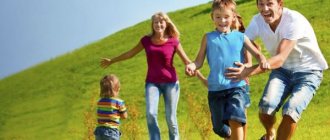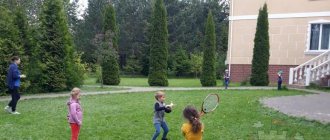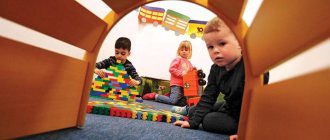Article: “Physical education in kindergarten”
Starting from the second junior group, three classes per week are planned. Their duration in the junior group is at least 15 minutes, in the middle group - at least 20 minutes, in the senior group - at least 25 minutes, in the preparatory group - 30 minutes. If children have sportswear and there are no medical contraindications, one of the three physical education classes in the senior and preparatory groups should be held outdoors year-round. For regions of the middle zone in the winter season, physical education classes on the site, as well as walking for children 5–7 years old, are not carried out at air temperatures below –20°C and wind speeds of more than 15 m/sec. In the warm season, under favorable weather conditions, it is recommended to conduct the maximum number of activities outdoors. There are various options for conducting physical education classes:
traditional classes;
classes consisting of a set of outdoor games of high, medium and low intensity;
classes – training in basic types of movements;
Rhythmic gymnastics;
classes-competitions, where children identify the winners during various relay races of two teams;
test classes, during which children pass physical education standards;
story-based activities, etc.
Physical education and health work includes morning exercises, outdoor games and physical exercises on walks (morning and evening), and a physical exercise minute. Morning exercise helps to awaken the child’s body, moderately affects the muscular system, activates the activity of the cardiovascular, respiratory and other body systems, stimulates the work of internal organs and sensory organs, promotes the formation of correct posture, good gait, and prevents the occurrence of flat feet. Morning exercises are valuable because children develop the habit and need to do physical exercise every day in the morning. In addition, it provides an organized start to the day in kindergarten and makes it possible to switch children’s attention to joint forms of activity. The duration of morning exercises in the 1st junior group is 4-5 minutes, in the 2nd junior group - 5-6 minutes, in the middle group - 6-8 minutes, in the senior group - 8-10 minutes, in the preparatory group - 10-12 minutes. The optimal place for morning exercises in the warm season is the group's playgrounds, and in the cold season - the group room. Depending on the ambient temperature, children exercise in lightweight clothing or panties. In the health complex of morning exercises, in addition to general developmental exercises. They include breathing exercises and special exercises to strengthen the muscles of the back and foot. Health jogging of varying intensity for 3 minutes. Particular attention is paid to improving the functions of external respiration, for which children are taught to combine movement with inhalation and exhalation, include so-called “breathing exercises” with the pronunciation of sounds and syllables, and pay attention to the formation of correct nasal breathing. Children's stay in the fresh air is of great importance for physical development. Walking is the first and most accessible means of hardening a child’s body. It helps to increase its endurance and resistance to adverse environmental influences, especially colds. During the walk, children play and move a lot. Movement increases metabolism, blood circulation, gas exchange, and improves appetite. Children learn to overcome various obstacles, become more agile, dexterous, courageous, and resilient. They develop motor skills and abilities, strengthen the muscular system, and increase vitality. Properly organized and thoughtful walks help to achieve the goals of the comprehensive development of children. Children are allowed to spend up to four hours a day outdoors. In summer this time increases significantly. The daily routine of the kindergarten includes a daytime walk after classes and an evening walk after afternoon tea. The time allotted for walking must be strictly observed. On the site there are places for outdoor games and the development of children's movements: climbing fences (triangular, tetrahedral and hexagonal), a log for balance exercises, a slide, equipment for jumping and throwing exercises. All this should have an attractive appearance, be durable, well processed, secured and appropriate for the age of the children. Planning the content of children's activities during a walk depends on the time of year, weather, previous activities, interests and age. An important component of organized physical activity is outdoor games played during a walk in the first half of the day. To achieve an optimal training effect, use high-intensity outdoor games, sports games, competition games, relay races or running at an increasing pace for 3–5 minutes, depending on age (1–2 games or jogging, alternating them with periods of independent activity). In the summer, outdoor play is supplemented with elements of hardening (playing with water). They develop basic movements, relieve mental stress from classes, and develop moral qualities. An outdoor game can be played at the beginning of a walk if the activities involved children sitting for a long time. If they go for a walk after a music or physical education lesson, then the game can be played in the middle of the walk or half an hour before it ends. The choice of game depends on the time of year, weather, air temperature. On cold days, it is advisable to start your walk with games of greater mobility associated with running, throwing, and jumping. Fun and exciting games help children cope better with cold weather. In damp, rainy weather (especially in spring and autumn), sedentary games that do not require a lot of space should be organized. Games with jumping, running, throwing, and balance exercises should also be carried out on warm spring, summer days and early autumn. During walks, plotless folk games with objects can be widely used, and in older groups - elements of sports games: volleyball, basketball, gorodki, badminton, table tennis, football, hockey. In addition to outdoor games and individual exercises in basic movements, sports activities (exercises) are also organized during the walk. During the walk, the teacher makes sure that all the children are busy, not bored, and that no one gets cold or overheated. He attracts very active children to participate in calmer games. About half an hour before the end of the walk, the teacher organizes quiet games. The right combination of different types of daily physical exercise and outdoor games helps to ensure rational motor activity for children. Mastering the program material in the classroom is the basis for all physical education and recreational activities and independent exercises and games for children.
Why was physical therapy introduced in kindergartens?
Of course, you need to do therapeutic exercises with your child both at home and in specialized medical institutions. However, research shows that the greatest effect is achieved precisely by training in a kindergarten setting.
The main reasons encouraging the introduction of physical therapy in preschool educational institutions:
- An increase in the number of children with congenital pathologies of various organs and systems;
- Deterioration of environmental conditions that negatively affect the child’s body’s ability to adapt;
- The child’s sedentary lifestyle, preference for games on electronic devices;
- High workload of parents at work, lack of time to spend with children;
- Low availability of medical care - remoteness of clinics and hospitals, strict work schedules, long queues.
Thus, kindergarten turns out to be the most accessible place where kids can regularly exercise and improve their health.
Features of physical education in modern kindergartens
The physical development of the baby is the object of constant monitoring by specialists, both pedagogical and medical. Therefore, the task of each institution that draws up physical education projects in preschool educational institutions with children is to prepare such programs that will fully meet the requirements of these specialists.
Modern pedagogical practice allows for the only form of work with children, this includes traditional classes that contribute to achieving positive dynamics in the matter of the child’s physical development. All methods of conducting physical education exercises in preschool institutions are based on the need to solve 2 most important problems:
- organization of such a health complex that promotes the formation of an optimal sequence of movement and gradual increases in physical activity, which will further help strengthen the child’s immunity, and also have a positive effect on stimulating psychophysiological development. This will prevent the development of many pathological changes in the body;
- meeting age-related needs for physical exercise, which should be perceived by every child as “muscular joy”, and by educators as the main means of comprehensive development of preschool children. During such physical education classes, children not only understand the characteristics and capabilities of their body, but also communicate with peers through competitions in attentiveness and dexterity.
Some features of conducting classes in preschool educational institutions
Therapeutic gymnastics classes in preschool educational institutions are recommended to be carried out at least 2 times a week. The duration of training for children under 5 years old is 20-25 minutes, for 5-7 year old children - 30-35 minutes. The lesson consists of 3 parts:
- Introductory – 5-7 min. Organizing children before training - conversations about health and the benefits of exercise therapy, short play or dance exercises.
- Main – 15-20 min. Performing a set of exercises aimed at strengthening various organs and systems, including gymnastic elements with sports equipment.
- Final – 3 min. Smooth return of children to a state of rest - sedentary games, breathing exercises, self-massage of the feet.
In addition to complex exercise therapy classes twice a week, it is necessary to maintain children’s physical activity at a high level every day: conduct physical education sessions, finger exercises, and outdoor and indoor games.
When planning training – both for adults and children – the following recommendations are taken into account:
- You need to increase the load gradually, increasing the number of repetitions and the total number of exercises.
- Tasks are selected in accordance with the age and physical condition of the child.
- Classes should be held regularly, evenly distributed throughout the week.
- Each exercise is repeated several times to develop the correct dynamic stereotypes.
- Complex elements should be alternated with relatively simple ones, with relaxation exercises.
- Every 2-3 weeks it is advisable to adjust the gymnastic complex and update the exercises.
- It is important to monitor the condition of children during classes. If one of the kids cannot cope with the loads, then the complex should be made easier for him. There is no need to force preschoolers to exercise to the limit of their physical capabilities - this will cause a disruption in compensation.
Standard sets of exercises
If a child constantly exercises, his appetite and activity increase throughout the day. All exercises are selected in such a way as to affect the muscles of the spine, neck, lower back, shoulders, limbs and pelvis. The main goal pursued by educators is to influence the strengthening of the musculoskeletal system, as well as the prevention of diseases such as scoliosis.
It is best to do exercises in the fresh air, which is what all educators try to do in the warm seasons, and in winter a ventilated room is well suited, usually a sports or music room. Gymnastics along with hardening have a very good effect on a child’s body. In the future, this has a positive effect on the baby’s immune system and resistance to many diseases.
The set of exercises includes three stages:
- introductory part. Exercises (rotations of the head, circular movements of the arms, turns of the torso, bending);
- basic exercises. Stretching the muscles of the arms, legs and back, squats with gradually increasing repetitions, push-ups (if possible);
- final part. Light jogging with a step, shaking the muscles to relax.
The first stage includes various types of walking, as well as running, which are necessary to gradually activate different muscle groups. Next, you can begin exercises that will help strengthen and strengthen muscles, as well as joint mobility, posture and coordination. As for the final part, this usually includes some types of gymnastics and moderate walking.
What forms of classes are used
Since it can be difficult to get a child to play sports, instructors in kindergartens come up with unusual and interesting forms of training.
Children under 5 years old
To interest your child in training, it is best to conduct it in a playful way, while simultaneously telling some fascinating story or fairy tale. For example, while doing exercises, children can imagine that they are picking mushrooms and berries, swimming on the sea, flying with their wings spread, jumping like bunnies.
For children, activities using sports equipment - balls, hoops, fitballs, gymnastic mats - are of particular interest. To prevent flat feet, it is useful for children 2-3 years old to walk in socks on massage mats and ribbed paths. Children 4-5 years old are recommended to roll balls with their feet and walk on their toes and heels.
Workouts are more fun with music that creates a cheerful mood and improves your mood.
Up to 5-7 years
Children of older preschool age already have access to more complex gymnastic elements, rope training, and wall bars. You can include a competitive element in training, conduct relay races, and team games. Running, squats, stretching, and simple acrobatic exercises are required.
Dance gymnastics is very popular in older groups. The exercises are performed synchronously, to the music, in the rhythm of the dance.
Activities in the pool are also useful for children. Not only swimming, but also water aerobics and ball games.


